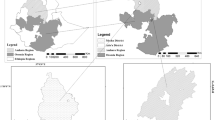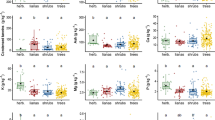Abstract
In this paper we focus on the functional role of trees for livestock as fodder in silvopastoral systems, available for (dairy) cows within or around pastures. Farmers often report that cows browse from trees, however, little is known about the nutritional value of different tree species. Therefore, the objective of this study was to assess the effect of soil type and season on the nutritional potential of leaves from Fraxinus excelsior, Alnus glutinosa and Salix viminalis. Leaf samples were collected at 10 sites in the Netherlands on clay and on sandy soils in June, July and September and were analysed for digestibility, crude protein, macro and micro element concentrations. We conclude that the nutritional value of tree leaves differs between the studied tree species. Regarding the seasonal variation, we found a main effect of sampling period on the crude protein, calcium, phosphorus, copper and selenium concentration of leaves. No main effect of soil type was found on the nutritional value of leaves. Significant interactions were found for species × sampling period (digestibility, calcium, sulphur) and species × soil (digestibility, calcium). For the zinc and selenium concentration in tree leaves, a significant species × soil × sampling period interaction was found. We conclude that trees can play a role for supplying protein, and macro and micro elements to livestock, but that it depends on which tree species is used.


Similar content being viewed by others
References
Azim A, Khan AG, Ahmad J, Ayaz M, Mirza IH (2002) Nutritional evaluation of fodder tree leaves with goats. Asian Australas J Anim Sci 15(1):34–37
Baker D, Mullin BC (1992) Actinorhizal symbioses. In: Gary Stacey, Robert H. Burris, Harold J. Evans (eds) Biological nitrogen fixation. Chapman and Hall, New York, pp 259–292
Ball DF (1964) Loss-on-ignition as an estimate of organic matter and organic carbon in non-calcareous soils. J Soil Sci 15:84–92. https://doi.org/10.1111/j.1365-2389.1964.tb00247.x
Barry T, Kemp P (2001) Ewes respond to poplar feed. Tree Feed 1:2–3
Becker M, Nehring K (1965) Handbuch der Futtermittel 2. Band. Verlag Paul Parey, Hamburg and Berlin
BIS Nederland (2013) http://maps.bodemdata.nl/bodemdatanl/index.jsp. Accessed 15 May 2013
Charlton J, Douglas G, Wills B, Prebble J (2003) Farmer experience with tree fodder. using trees on farms. Grassl Res Pract Ser 10:7–16
Côté B, Dawson JO (1991) Autumnal allocation of phosphorus in black alder, eastern Cottonwood, and white basswood. Can J For Res 21:217–221. https://doi.org/10.1139/x91-026
CVB (2005) Handleiding Mineralenvoorziening; Rundvee, Schapen, Geiten. Commissie Onderzoek Minerale Voeding. Centraal Veevoeder Bureau, Lelystad
Emile JC, Delagarde R, Barre P, Novak S (2016a) Nutritive value and degradability of leaves from temperate woody resources for feeding ruminants in summer. Poster presentation at 3rd European Agroforestry Conference Montpellier, 23–25 May 2016, France
Emile JC, Delagarde R, Barre P, Novak S (2016b). Nutritive value and degradability of leaves from temperate woody resources for feeding ruminants in summer. 3rd European Agroforestry Conference. Montpellier, 23–25 May 2016, France, pp. 409–412
Emile JC, Barre P, Delagarde R, Niderkorn V, Novak S (2017) Les arbres, une ressource fourragère au pâturage pour des bovins laitiers? Fourrages 230:155–160
Erisman JW, Brasseur G, Ciais P, van Eekeren N, Theis TL (2015) Global change: put people at the centre of global risk management. Nature 519:151–153
Erisman JW, Van Eekeren N, De Wit J, Koopmans C, Oerlemans N, Koks B (2016) Agriculture and biodiversity: a better balance benefits both. AIMS Agric Food 1:157–174. https://doi.org/10.3934/agrfood.2016.2.157
EU (2013) Overview of CAP reform 2014–2020. European Union, DG Agriculture and Rural Development, Buenos Aires
Faye MD, Weber JC, Mounkoro B, Dakouo J-M (2010) Contribution of parkland trees to farmers’ livelihoods: a case study from Mali. Dev Pract 20(3):428–434
Franzel S, Kiptot E, Lukuyu B (2014) Agroforestry: fodder trees. Reference Module in food science encyclopedia of agriculture and food systems. pp 235–243
Frutos P, Hervás G, Giráldez FJ, Mantecó AR (2004) Review. Tannins and ruminant nutrition. Span J Agric Res 2(2):191–202
Guo D, Xia M, Wei X, Chang W, Liu Y, Wang Z (2008) Anatomical traits associates with absorption and mycorrhizal colonization are linked to root branch order in twenty-three Chinese temperate tree species. New Phytol 180:673–683
Gupta CU, Gupta SC (2000) Selenium in soils and crops, its deficiencies in livestock and humans: implications for management. Commun Soil Sci Plant Anal 31(11–14):1791. https://doi.org/10.1080/00103620009370538
Hejcman M, Hejcmanová P, Stejskalová M, Pavlů V (2014) Nutritive value of winter-collected annual twigs of main European woody species, mistletoe and ivy and its possible consequences for winter foddering of livestock in prehistory. The Holocene 24(6):659–667
Houba VJG, Temminghoff EJM, Gaikhorst GA, van Vark W (2000) Soil analysis procedures using 0.01 M calcium chloride as extraction reagent. Commun Soil Sci Plant Anal 31:1299–1396. https://doi.org/10.1080/00103620009370514
Huber J, Häberle K-H, Blaschke H, Schmidt H, Hülsbergen K-J (2012) Fine root morphology of four tree species in two differently managed agroforestry systems. Poster International Society of Root Research, Dundee, Scotland, 26–29 June 2012
Kacálková L, Tlustoš P, Száková J (2015) Phytoextraction of risk elements by willow and poplar trees. Int J Phytorem 17(1–6):414–421
Kemp PD, Mackay AD, Matheson LA, Timmins ME (2001) The forage value of poplars and willows. Proc N Z Grassl Assoc 63:115–119
Kjeldahl J (1983) Neue methode zur Bestimmung des Stickstoffs in organischen Körpern (New method for the determination of nitrogen in organic substances). Z Anal Chem 22(1):366–383
Le Houérou HN (2006) Environmental constraints and limits to livestock husbandry in arid lands. Science et chang planétaires/Sécheresse 17(1):10–18
Luske B, van Eekeren N (2014) Renewed interest for silvopastoral systems in Europe–an inventory of the feeding value of fodder trees. Build Organ Bridges 3:811–814
Luske B, Meir I van, Altinalmazis Kondylis A, Roelen S, van Eekeren N (2017). Online fodder tree database for Europe. Louis Bolk Institute and Stichting Duinboeren, the Netherlands. www.voederbomen.nl/nutritionalvalues/. Accessed 9 Oct 2017
Machatschek M (2002) Laubgeschichten. Böhlau Verlag, Wien, Gebrauchswissen Schaft einer alten Baumwirtschaft, Speise- und Futterlaubkultur, p 542
McSweeney CS, Palmer B, McNeill DM, Krause DO (2001) Microbial interaction with tannins: nutritional consequences for ruminants. Anim Feed Sci Technol 91(1–2):83–93. https://doi.org/10.1016/S0377-8401(01)00232-2
McWilliam EL, Barry TN, Lopez-Villalobosa N, Cameron PN, Kemp PD (2005) Effects of willow (Salix) versus poplar (Populus) supplementation on the reproductive performance of ewes grazing low quality drought pasture during mating. Anim Feed Sci Technol 119:69–86
Mosquera-Losada MR, McAdam JH, Romero-Franco R, Santiago-Freijanes JJ, Rigueiro-Rodróguez A (2009) Definitions and components of agroforestry practices in Europe. In: Rigueiro-Rodríguez A, McAdam J, MR Mosquera-Losada (eds). Agroforestry in Europe: current status and future prospects. Springer, Netherlands pp 3–19
Nair PKR (2012) Climate change mitigation: a low-hanging fruit of agroforestry. In: Nair PKR, Garrity D (eds) Agroforestry—the future of global land use. Springer, Dordrecht, pp 31–67
Nijman M (2002) Bomen en struiken als Veevoer. Een alternatief voor het voeren van mineralen en sporenelementen aan biologische melkkoeien. Afstudeerscriptie Hogeschool Delft. Louis Bolk Instituut, Driebergen, the Netherlands
Paterson R, Karanja G, Nyaata O, Kariuki I, Roothaert R (1998) A review of tree fodder production and utilization within smallholder agroforestry systems in Kenya. Agrofor Syst 41(2):181–199
Petit S, Watkins C (2004) Forgotten peasant practices: tree pollarding in Great Britain. Etudes Rurales 169:197–214
Pitta DW, Barry TN, Lopez-Villalobos N, Kemp PD (2005) Effects on ewe reproduction of grazing willow fodder blocks during drought. Anim Feed Sci Technol 120:217–234
Pregitzer KS (2008) Tree root architecture—form and function. New Phytol 180:564–568
Rahmann G (2004) Gehölzfutter—eine neuwe quelle für die öcologische tiernährung. Landbouforschung Völkenrode Sonderheft 272:29–42
Rahmann G, Seip H (2007) Bioactive forage and phytotherapy to cure and control endo-parasitic diseases in sheep and goat farming systems—a review of current scientific knowledge. Landbauforschung Völkenrode 3(57):285–295
Robinson PJ (1985) Trees as fodder crops. In: Cannell MGR, Jackson JE (eds) Attributes of trees as crop plants. Institute of Terrestrial Ecology, Abbots Ripton, pp 281–296
Robinson B, Mills T, Green S, Chancarel B, Clothier B, Fung L, Hurts S, McIvor I (2005) Trace element accumulation by poplar and willows used for stock fodder. N Z J Agric Res 48(4):489–497. https://doi.org/10.1080/00288233.2005.9513683
Rotherham ID (2007) Wild gorse: history, conservation, and management. Farming and wildlife advisory group Scotland 7: 17–21. http://ukeconet.org/wp-content/uploads/2009/10/FWAG_Gorse_2007.pdf. Accessed 13 Jun 2017
Saramäki J, Hytönen J (2004) Plantations of silver birch (Betula pendula Roth) and downy birch (Betula pubescens Ehrh.) on former agricultural soils. Balt For 10(1):1–11
Schroth G (1995) Tree root characteristics as criteria for species selection and systems design in agroforestry. Agrofor Syst 30:125–143
Schroth G (1999) A review of belowground interactions in agroforestry, focussing on mechanisms and management options. Agrofor Syst 43:5–34
Sinclair FL, Verinumbe I, Hall JB (1994). The role of tree domestication in agroforestry. In: Leakey RRB, Newton A (eds) Tropical trees: potential for domestication and the rebuilding of forest resources. HMSO, London, pp. 124–136
Slotte H (2001) Harvesting of leaf-hay shaped the Swedish landscape. Landsc Ecol 16(8):691–702. https://doi.org/10.1023/A:1014486331464
Smith J, Leach K, Rinne M, Kuoppala K, Padel S (2012) Integrating willow-based bioenergy and organic dairy production—the role of tree fodder for feed supplementation. In: Rahmann G, Godinho D (eds) Tackling the future challenges of organic husbandry. Proceedings of the 2nd OAHC, Hamburg
Solorio Sanchez FJ, Solorio Sánchez B (2002) Integrating fodder trees into animal production systems in the tropics. Trop Subtrop Agroecosyst 1:1–11
Speedy A, Pugliese P-L (1992) Legume trees and other fodder trees as protein sources for livestock. Proceedings of the FAO Expert Consultation Kuala Lumpur, Malaysia, 14–18 October 1991. FAO, Rome. http://www.fao.org/docrep/003/T0632E/T0632E00.HTM. Accessed 06 Jun 2017
Thapa B, Walker D, Sinclair F (1997) Indigenous knowledge of the feeding value of tree fodder. Anim Feed Sci Technol 67(2–3):97–114
Tilley JMA, Terry RA (1963) A two-stage technique for the in vitro digestion of forage crops. Grass Forage Sci 18(2):104–111
Torralba M, Fagerholm N, Burgess PJ, Moreno G, Plieninger T (2016) Do European agroforestry systems enhance biodiversity and ecosystem services? A meta-analysis. Agric Ecosyst Environ 230:150–161
Trémolières M, Schnitzler A, Sanchez- Pérez J-M, Schmitt D (1999) Changes in foliar nutrient content and resorption in Fraxinus excelsior L., Ulmus minor Mill. and Clematis vitalba L. after prevention of floods. Ann For Sci 56:641–650
Van den Pol-van Dasselaar A, Aarts H, De Caesteker E, De Vliegher A, Elgersma A, Reheul D, Verloop J (2015) Grassland and forages in high output dairy farming systems in Flanders and the Netherlands. Grassl Sci Eur 20:3–25
Van Eekeren N (1999) Relatie calcium-gehalte in gras-klaver en klaveraandeel. Vlugschriften Louis Bolk Instituut, Driebergen, the Netherlands
Vandermeulen S, Ramírez-Restrepo C-A, Marche C, Decruyenaere V, Beckers Y, Bindelle J (2016) Behaviour and browse species selectivity of heifers grazing in a temperate silvopastoral system. Agrofor Syst. https://doi.org/10.1007/s10457-016-0041-x
Wroblewska H, Kozik E, Czajka M (2009) Content of macro- and microcomponents in willow (Salix Purpurea L.) grown in substrates with composts of post-use wood waste. Folia For Pol Ser B 40:23–30
Young A (1989) Agroforestry for soil conservation, vol 4. CAB international, Wallingford
Acknowledgements
We are very thankful for the ten farmers who were willing to cooperate, members of the Duinboeren and the Farmer’s Network for Fodder Trees and Multifunctional Land Use. Furthermore we are grateful to Maaike Stoffelsma, Andreas Altinalmazis Kondylis, Suzanne Roelen and Nyncke Hoekstra who assisted us in conducting the field work and improving of the manuscript. We acknowledge support of the Dutch Ministry of Economic Affairs, The European Agricultural Fund for Rural Development and the European Commission through the AGFORWARD FP7 research project (Contract No. 613520).
Author information
Authors and Affiliations
Corresponding author
Rights and permissions
About this article
Cite this article
Luske, B., van Eekeren, N. Nutritional potential of fodder trees on clay and sandy soils. Agroforest Syst 92, 975–986 (2018). https://doi.org/10.1007/s10457-017-0180-8
Received:
Accepted:
Published:
Issue Date:
DOI: https://doi.org/10.1007/s10457-017-0180-8




